- How we help you
Back
- Owner drivers
Back
- All benefits
- Calculate earnings
- Find loads & return journeys
- Leave multidrop
- Expand your network
- Manage finances
- Courier companies
Back- All benefits
- Calculate earnings
- Find loads & return journeys
- Reduce dead miles
- See average courier rates
- Find subbies
- Manage your fleet
- Shippers
Eddy’s Logistics: From gig work to courier business
Discover how Eddy’s Logistics went from gig work to courier business in just two years, with the support of Courier Exchange.
Dan Solomon — Updated
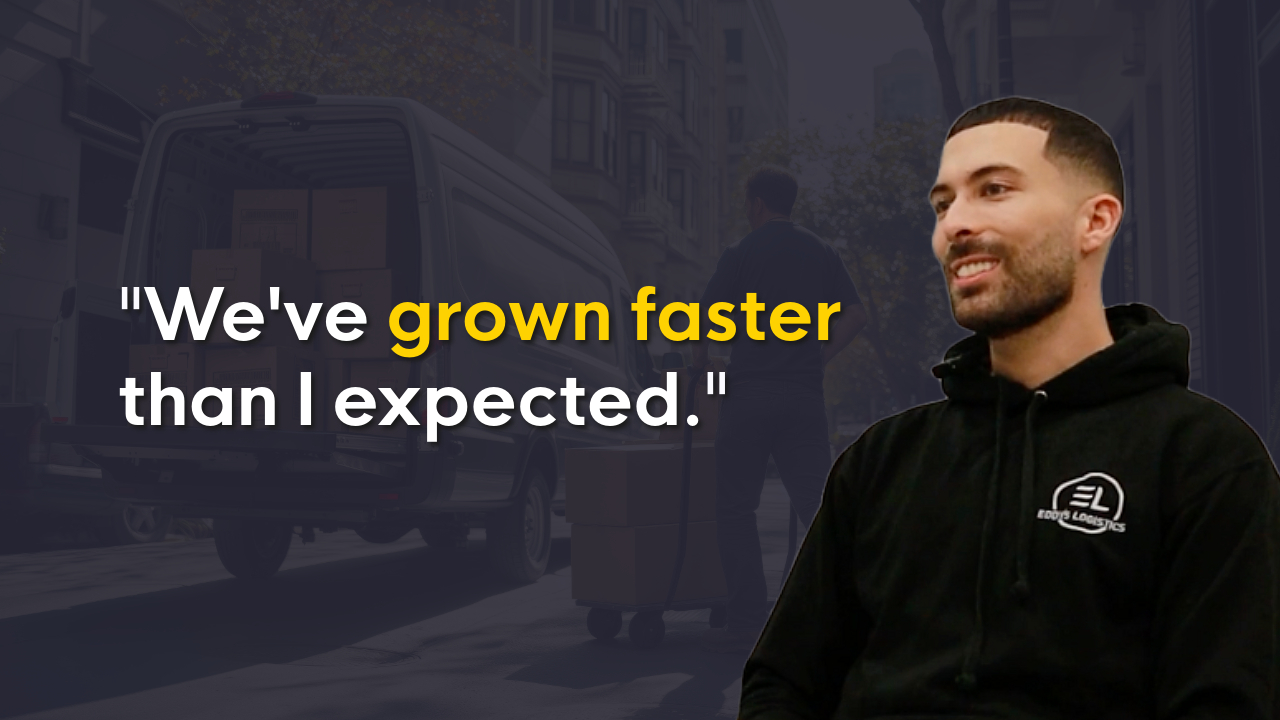
In 2022, Eddy Martinho was delivering for a Lebanese restaurant after a stint as an Uber Eats driver. While the work kept him busy, he knew it wasn’t what he wanted long-term. That’s when a friend introduced him to Courier Exchange.
After researching the platform, Eddy decided to “give it a try” and started Eddy’s Logistics.
Through hard work, professionalism, and building strong connections, Eddy’s Logistics has grown rapidly. Eddy has also established a popular YouTube channel and is now focused on expanding his business even further.
Here’s how he made it happen.
Eddy joined CX in September 2022. “Everyone said it was the best time because it’s so busy leading up to Christmas,” he recalls.
Determined to make the most of it, Eddy focused on building a reputation for reliability, taking on as many jobs as possible during the busy season. “I worked flat out from September to December. I didn’t care if I had to sleep in a van or drive overnight to Edinburgh or Liverpool—I just got it done,” he says.
Eddy also knew that quieter months were part of being a courier, so he wasn’t caught off guard when things slowed down in the new year. “January was quieter, but I expected that. By March, things picked up again, and it’s been growing ever since.”
For Eddy, CX wasn’t just a job-finding platform—it was a way to grow his network and secure contracts. A lot of people think CX is just for finding work, but it’s also about building relationships,” Eddy explains.
A lot of people think CX is just for finding work, but it’s also about building relationships.
Eddy Martinho, Founder and Director, Eddy’s LogisticsBy working with courier companies on the platform, Eddy formed long-term connections that became the foundation of his business.
When Eddy wanted to scale up, he relied heavily on CX to help him.
“I started with a Transit Courier van, which is very small. When I couldn’t take larger jobs, I used CX to subcontract work to other couriers and haulage drivers with great feedback,” he says. “This helped me build trust with shippers, and they started relying on me for all their deliveries.”
Like any success story, Eddy’s journey wasn’t without its challenges. “I had a standstill period where I felt like I wasn’t moving forward,” he shares. That’s when Eddy decided to put himself out there more. By becoming active on social media and launching his YouTube channel, Eddy’s Logistics, he started attracting new clients. “Once I did that, clients started coming to me instead of me chasing them,” he says.
Get access to 13,000+ courier loads a day on Courier Exchange
Sign up
Be your own boss. Set your own hours. Make your own money.Results
Eddy’s hard work, focus and strategic use of CX to build his business is paying off.
2 years
As a CX member
349
Positive reviews
“We’ve been growing quickly—faster than I expected.”
In fact, Eddy says “A lot of work now comes from CX, private customers, and direct calls from clients I first met on the platform.”
His YouTube channel, @EddysLogistics, has also become another pillar of his success. With 2.7k followers, it’s a space where Eddy shares advice, engages with the courier community, and grows his personal brand. This has opened new opportunities and strengthened the presence of Eddy’s Logistics in the industry.
Conclusion
What’s next for Eddy’s Logistics?
“I want to step back from driving and focus on working on the business instead of in it. This means growing relationships, securing contracts, and expanding further,” he says.
Reflecting on his success, Eddy highlights the importance of professionalism.
Being on time, reliable, and presentable makes a big difference.
Eddy Martinho, Founder and Director, Eddy’s LogisticsFrom delivering food on his motorbike to building a growing courier business, the story of Eddy’s Logistics shows how hard work, professionalism, and the right tools can lead to success.
Get access to 13,000+ daily loads on Courier Exchange
Be your own boss. Set your own hours. Make your own money.
Sign upBuilding trust as a courier is key for long-term success in the competitive logistics industry. Customers rely on couriers to deliver their loads safely and on time, making trust an important part of your courier business.
Here are the most important considerations for couriers looking to build trust and grow their reputation with their clients.
Get access to 13,000+ courier loads a day on Courier Exchange
Sign up
Be your own boss. Set your own hours. Make your own money.What we’ll cover
Building trust with clear communication
Effective communication is the foundation of trust. Keeping customers informed about the status of their deliveries, from pickup to drop-off, is very important.
It is particularly important to inform your customer as soon as possible if you’re running late, or to communicate about any issue that can affect the delivery.
Clear communication helps manage customer expectations and reduces stress. Always be available to answer any questions or concerns promptly.
Grow your reputation through punctuality
Punctuality is vital in the logistics business. Arriving at pickup and delivery points on time shows professionalism and reliability.
Plan your routes carefully and account for potential delays, especially if you’re navigating cities like London. And always aim to stick to the promised schedule.
Consistently meeting delivery times will significantly enhance your reputation and foster customer trust.
Good manners and friendly service
The way you interact with customers can make a lasting impression. Good manners and friendly service go a long way in building positive relationships.
Greet customers warmly, thank them for their business, and handle their cargo with care. A courteous and positive attitude can turn a one-time customer into a loyal client.
Professionalism
Professionalism should be clear in every part of your service. This includes your appearance, behaviour, and the way you handle packages.
Dress neatly, wearing appropriate clothing that reflects well on your business. Handle packages with care, ensuring they are delivered in the same condition as when they were picked up.
Showing professionalism proves that you take your job seriously and respect your customers’ goods.
Safety measures
Keeping loads safe during transit is very important. Handle all cargo with care to prevent damage.
Use appropriate equipment and secure items properly in your vehicle. Avoid stacking heavy items on top of fragile ones and be mindful of temperature-sensitive deliveries.
By focusing on safety, you can prevent damage and build trust with customers who know their items are in good hands.
Problem resolution
No matter how careful you are, issues may occasionally arise. How you handle these problems can greatly impact your reputation.
Address any complaints or issues promptly and effectively. Listen to the customer’s concerns, apologise if necessary, and provide a solution as quickly as possible.
Showing a commitment to resolving problems demonstrates reliability and dedication to customer satisfaction.
Why it’s important to build trust
Building trust as a courier involves a combination of clear communication, punctuality, good manners, professionalism, attention to safety, and effective problem solving. By focusing on these areas, you can create a reliable and trustworthy service that customers will choose time and time again.
Trust is not built overnight, but with consistent effort and attention to detail, you can establish a strong reputation in the courier industry that will help you when growing your courier business.
Grow your business with Courier Exchange
Get access to 13,000+ loads a day, build your client list, and manage your finances.
Sign upWhen it comes to setting the right price for your courier jobs, it’s not just about covering costs. You also need to make sure you’re making a profit.
By carefully considering how you price your courier jobs, you can boost your income and grow your business.
The best way to start is by understanding your price per mile (PPM). This helps you see if a job is worth taking, and helps you stay you’re competitive while still earning well.
With the right strategy, you can find the sweet spot in pricing, and get more loads while increasing your profits. Keep reading to learn how to fine-tune your pricing strategy for the best results.
Get access to 13,000+ courier loads a day on Courier Exchange
Sign up
Be your own boss. Set your own hours. Make your own money.How to price your courier jobs
Journey distance
The distance you travel affects your fuel costs and the time you spend on the road. It’s important to calculate your mileage accurately. Use reliable mapping tools to determine the exact distance and consider any potential detours or delays.
Remember, longer distances mean higher fuel costs and more wear and tear on your vehicle.
Pricing your courier jobs based on location
Courier rates can vary significantly depending on whether you are delivering in urban or rural areas. Some locations are also better for couriers than others.
Urban deliveries often involve heavy traffic, which can lead to delays. On the other hand, rural deliveries might cover longer distances with less traffic.
Adjust your pricing to reflect these differences, ensuring that you account for any potential delays or additional time spent on the road.
Cargo type
Different types of cargo can impact how you price your courier jobs, especially if you offer specialist courier services.
For example, fragile items might require extra care and special handling, which can increase the time and effort needed for delivery. Hazardous materials may need specific licences like an ADR, and the proper equipment when loading and unloading.
Make sure to consider these factors when setting your prices.
Load size and weight
The size and weight of the cargo can significantly affect your costs. Larger or heavier items may reduce your vehicle’s fuel efficiency and require more space, limiting the number of deliveries you can make in one trip.
Make sure to factor in these elements when pricing your jobs. Charging more for bulky or heavy items helps cover the increased fuel consumption and reduced carrying capacity.
Setting courier rates by time and day
The time of day and day of the week can impact your delivery times and costs.
Peak hours, such as mornings and evenings, often involve heavier traffic, which can slow you down. Similarly, weekends and holidays might see increased demand but also heavier traffic.
Consider charging higher rates for deliveries during these times to compensate for the additional time and current fuel prices.
Toll roads, congestion charges, and ULEZ
When calculating how to price your courier jobs prices, don’t forget to include costs such as toll roads, congestion charges, and Ultra Low Emission Zone (ULEZ) fees.
These additional expenses can quickly add up, especially if you frequently travel through these areas. The CX Driver app allows you to list these costs separately when quoting for a load, making it easier to ensure all charges are covered.
Always calculate these costs accurately to avoid underpricing your services.
Operating costs
Running a courier business involves various operating costs that need to be included when set your pricing for jobs.
These costs include courier van maintenance, courier insurance, topping up your courier fuel card, and any other expenses necessary to keep your business running smoothly. It’s important to note that during less busy periods, your fixed costs, such as vehicle maintenance and insurance, remain the same. Therefore, it’s wise to factor in these fluctuations when pricing during busy times to ensure you cover for the slower periods.
Ensuring your pricing reflects these operating costs and seasonal demand fluctuations helps maintain profitability throughout the year.
Conclusion
Setting the right price for your courier jobs is essential for maximising your earnings as a courier. Before quoting for a job, make sure you’ve planned your route efficiently and calculated your costs accurately.
By considering factors like journey distance, location, cargo type, cargo size, time of day, and additional costs such as tolls and ULEZ fees, you can set prices that reflect your true costs and ensure profitability.
Regularly review and update your prices for courier work, taking into account not just your costs but also the average market price. As a CX member, you’ll have access to weekly average price-per-mile data for your vehicle type, so you can keep your quotes competitive in the marketplace.
There are busy times as well as slow times in the courier industry. You need to account for this and make sure that the higher profits in the busy times cover your fixed costs during the slower periods.
Lastly, you need to communicate clearly with your customers. Make sure your customers understand the factors that go into your prices. Clear communication helps manage expectations and builds trust.
Grow your business with Courier Exchange
Get access to 13,000+ loads a day, find reliable subcontractors, and manage your finances.
Sign upGrowing your courier business requires a lot of effort and persistence. But if you use the right methods and put the work in, you’ll start getting more loads and more clients.
Whether you’re an experienced owner-driver or just starting out, here are some tips to help you reach the next level.
Get access to 13,000+ courier loads a day on Courier Exchange
Sign up
Be your own boss. Set your own hours. Make your own money.What we’ll cover
Cold calls and emails
The most traditional way to reach potential clients is through cold calls and emails. While it may seem intimidating, it can be very effective if done correctly.
Crafting the perfect message
When sending emails, make sure they are concise and to the point. Avoid long messages and ensure all key information is included. A well-crafted email should grab the recipient’s attention and give them a reason to respond.
Cold calling tips
Prepare a script before making calls. This will help you stay focused and cover all the important points. Practice your script to sound natural and confident.
You’ll probably get a lot of rejections, but a successful call could turn into a valuable long-term business opportunity.
Persistence is key
Cold calling and emailing require patience. Expect a low response rate, but stay optimistic. Each new client can significantly contribute to your business growth.
Using social media to grow your courier business
In today’s digital age, social media is a powerful tool for growing your courier business.
Platforms like Instagram, Facebook, LinkedIn and even TikTok can help you reach a wider audience and engage with potential clients.
Building an online presence
Use social media to showcase your services and past work. Post regular updates about your business, share customer testimonials, and engage with your followers. An active online presence can attract potential clients and build trust.
Engagement and trust
Social media allows you to interact with your audience directly. Respond to comments and messages promptly. Engaging with your followers builds a sense of community and trust, which can lead to more business opportunities.
Networking
Social media platforms are great for networking. Connect with other professionals in the industry, join relevant groups, and participate in discussions. Networking can open doors to new partnerships and clients.
Word of mouth
Word of mouth is one of the most powerful ways to grow your courier business. Satisfied clients are your best promoters.
Grow your courier business with referrals
When clients are happy with your service, they are likely to recommend you to others. Encourage satisfied customers to refer you to their friends, family, and colleagues. A personal recommendation carries more weight than any advertisement.
Building a reputation
The longer you provide reliable service, the more referrals you’ll receive. Consistency and quality in your service will help you build a solid reputation. Over time, your reputation will attract more clients.
Word of mouth leads to steady growth. Each new client can bring in several more through referrals. This may take time, but it is highly effective in building a loyal customer base.
How Courier Exchange helps
Being a CX member is the quickest path to finding more work, connecting with potential clients and partners, and scaling your business.
The largest logistics platform in the UK, CX brings together the largest shippers and the best couriers, making it easy to find jobs, cut down on empty miles and even post excess work.
Access to a larger network
By joining the Courier Exchange, you can connect with a vast network of shippers and other couriers. With access to over 8,000 CX members nationwide, you will build relationships in the industry and increase your chances of finding work.
Thousands of daily loads
The Courier Exchange sees an average of at least 13,000 loads posted every day, giving you constant access to work. You can choose jobs that fit your schedule and route, making your operations more efficient.
You can pick and choose jobs based on your availability, local area, preferred routes, cargo type, etc. This flexibility helps you manage your time better and increase your earnings.
Successfully completing jobs on CX allows you to build a positive reputation within the community. Positive reviews and ratings on CX will attract even more work.
Conclusion
Growing your courier business requires consistent effort and the right strategies. By combining cold outreach, online engagement, word of mouth, and leveraging the Courier Exchange, you can steadily expand your client base.
Whether you are an experienced courier or just starting, these methods can help you grow your business. Remember, success doesn’t come overnight. However, with enough time and effort, there is no limit to how far you can scale a small courier business.
Keep at it, and you’ll start seeing results in no time.
Grow your business with Courier Exchange
Get access to 13,000+ loads a day, build your client list, and manage your finances.
Sign upChoosing a new courier van is a big decision for any courier.
With so many options available, it can be tough to find the right fit.
The van you choose will determine what jobs you can take on, and will impact your efficiency, costs, and customer satisfaction. That’s why it’s essential to make an informed choice.
In this guide, we’ll help you understand the different van sizes and features, and give you some examples. So you can find the perfect van for the long-term success of your courier business.
Get access to 13,000+ courier loads a day on Courier Exchange
Sign up
Be your own boss. Set your own hours. Make your own money.What we’ll cover
Short Wheelbase (SWB) Vans
Short wheelbase vans are perfect for city deliveries. They are easy to drive and park, even in tight spaces. These vans are ideal for couriers who mostly work in urban areas.

Renault Kangoo courier van
The Renault Kangoo is a reliable small van for couriers. It’s great for carrying light loads, as well as navigating London and other busy city streets.
- Load Area Dimensions: Length: 1,806mm, Width: 1,570mm, Height: 1,215mm
- Maximum Payload: 836-937kg
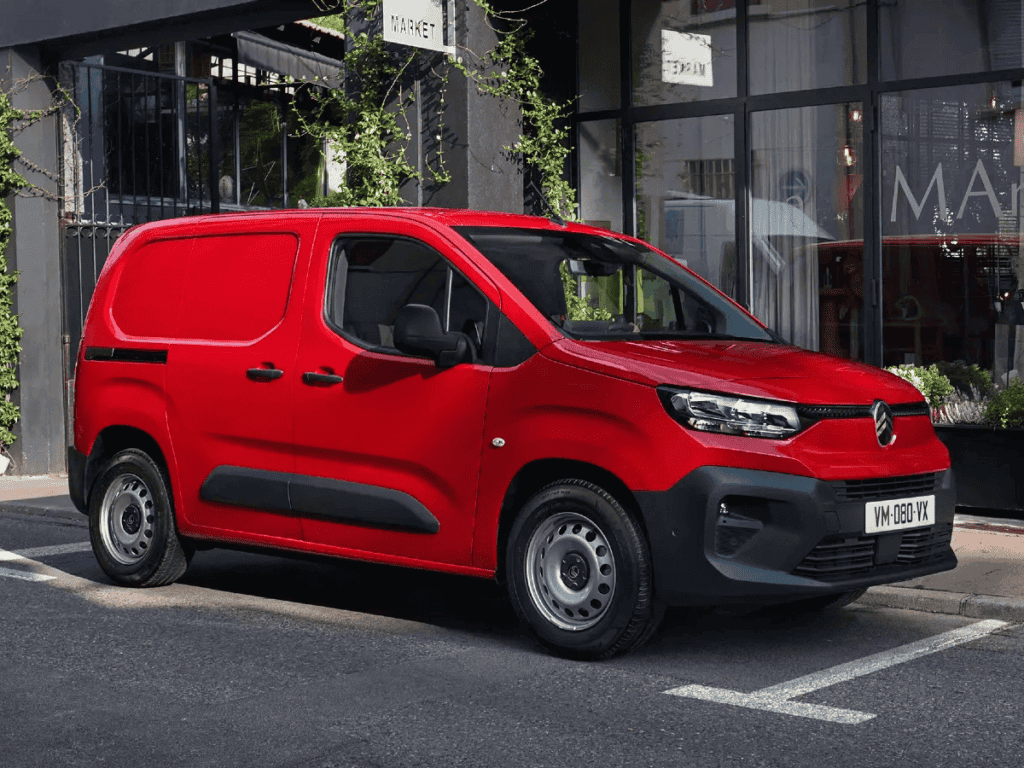
Citroën Berlingo
The Citroën Berlingo is another excellent choice for a small courier van. It offers a bit more space while still being compact.
- Load Area Dimensions: Length: 1,817mm, Width: 1,550mm, Height: 1,236mm
- Maximum Payload: 840-1059kg
Short wheelbase vans are ideal for busy locations for couriers, like London and Birmingham. Their small size makes them easy to handle and park, and they are efficient for quick deliveries.
Medium Wheelbase (MWB) Vans
Medium wheelbase courier vans strike a balance between size and manoeuvrability. They are suitable for a variety of delivery needs and are popular among many couriers.

Renault Trafic courier van
The Renault Trafic is a versatile van for couriers. It offers more space without being too large to handle.
- Load Area Dimensions: Length: 2,537mm, Width: 1,662mm, Height: 1,387mm
- Maximum Payload: 1,122-1,266kg
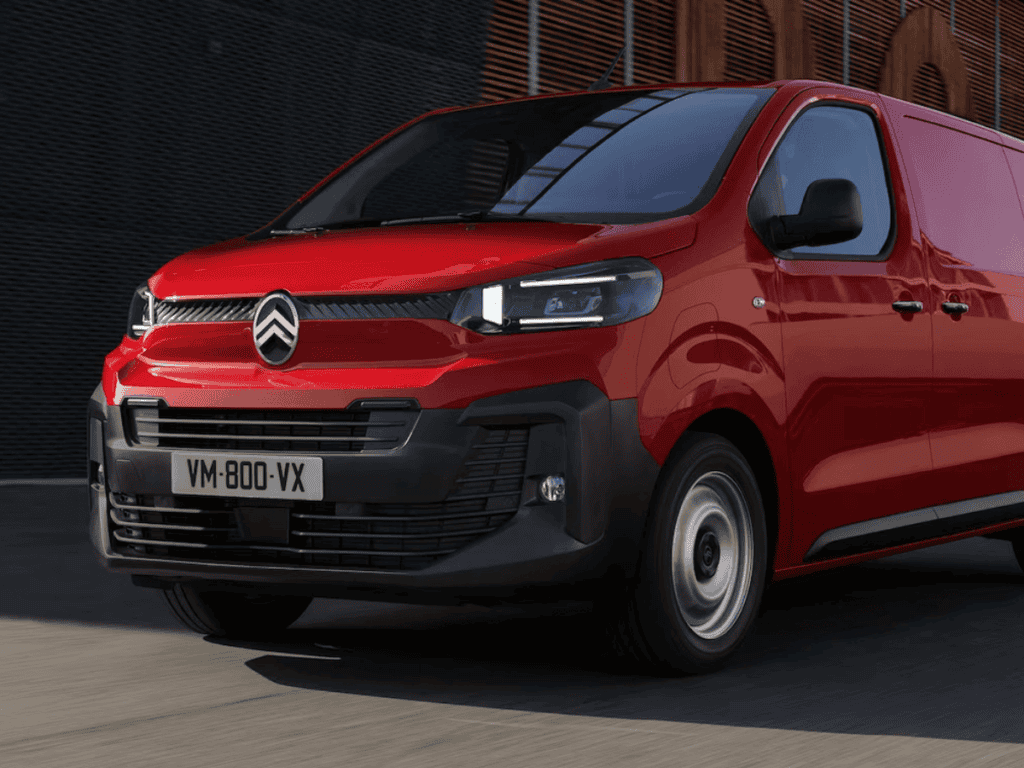
Citroën Dispatch
The Citroën Dispatch is another good option for medium wheelbase vans. It provides ample load space and is easy to drive.
- Load Area Dimensions: Length: 2,510mm, Width: 1,628mm, Height: 1,397mm
- Maximum Payload: 1,200-1,400kg
Medium wheelbase vans are popular for courier work because they offer a good mix of space and flexibility. They are perfect for couriers who need to carry a bit more without the bulk of a large van.
Long Wheelbase (LWB) Courier Vans
Long wheelbase vans are perfect for larger loads and longer distances. They are ideal for couriers who need more space and can handle driving a bigger vehicle.

Renault Master courier van
The Renault Master is a robust courier van. It’s great for heavy and bulky loads.
- Load Area Dimensions: Length: 3,083mm, Width: 1.765mm, Height: 1,894mm
- Maximum Payload: 1,200-1,971kg
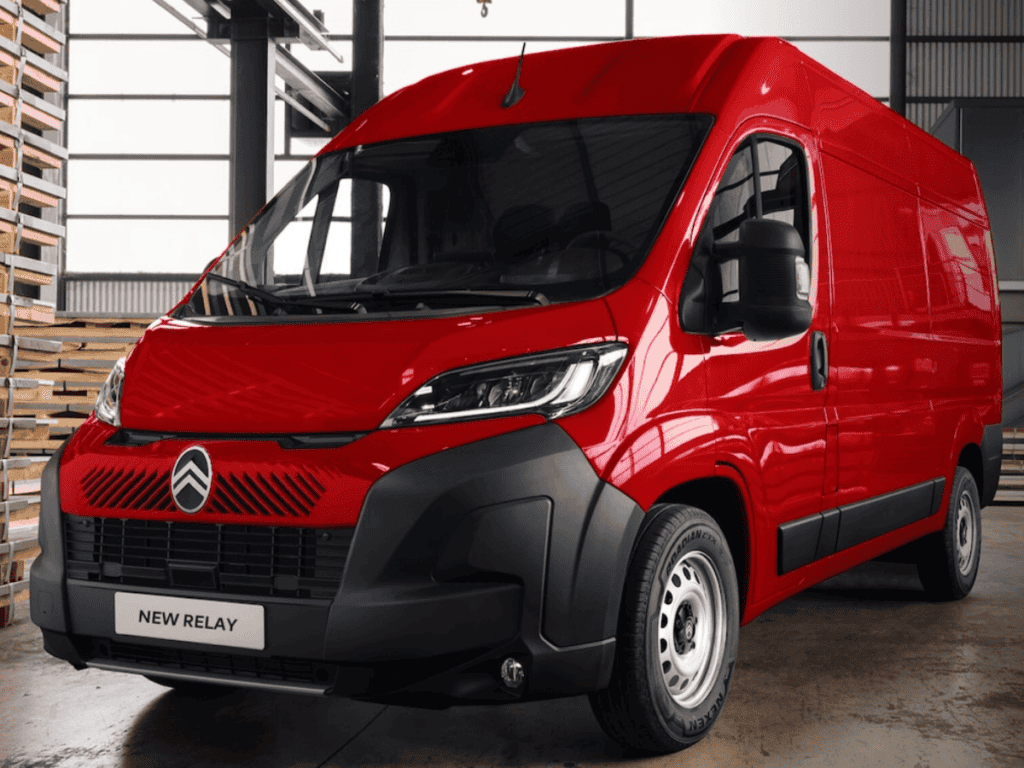
Citroën Relay
The Citroën Relay offers a lot of space and is perfect for long-distance courier work.
- Load Area Dimensions: Length: 3,120mm, Width: 1,870mm, Height: 1,662mm
- Maximum Payload: 1,150-2,000kg
Long wheelbase vans are the best choice for couriers who need to transport large items over long distances. They provide plenty of space and a higher payload capacity.
Extra Long Wheelbase (XLWB) Courier Vans
Extra long wheelbase vans offer the maximum cargo space. They are best for very long distances and large loads.
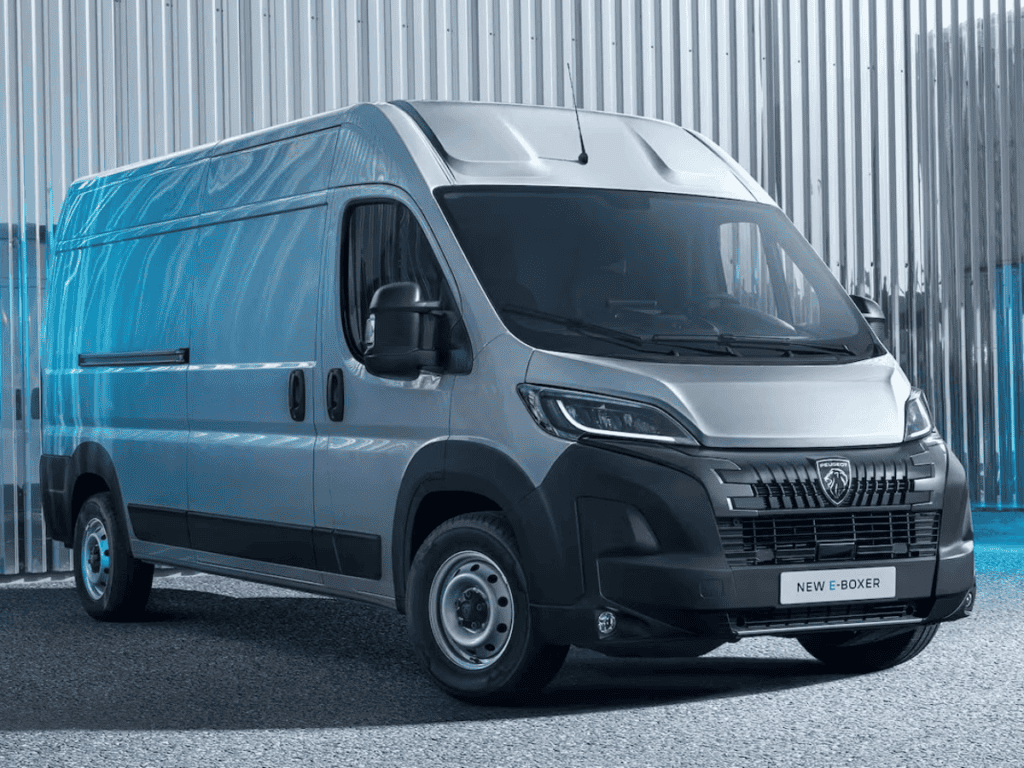
Peugeot Boxer
The Peugeot Boxer is a large van for couriers, offering plenty of space for big loads.
- Load Area Dimensions: Length: 4,070mm, Width: 1,870mm, Height: 3,920mm
- Maximum Payload: 1,340-1,900kg
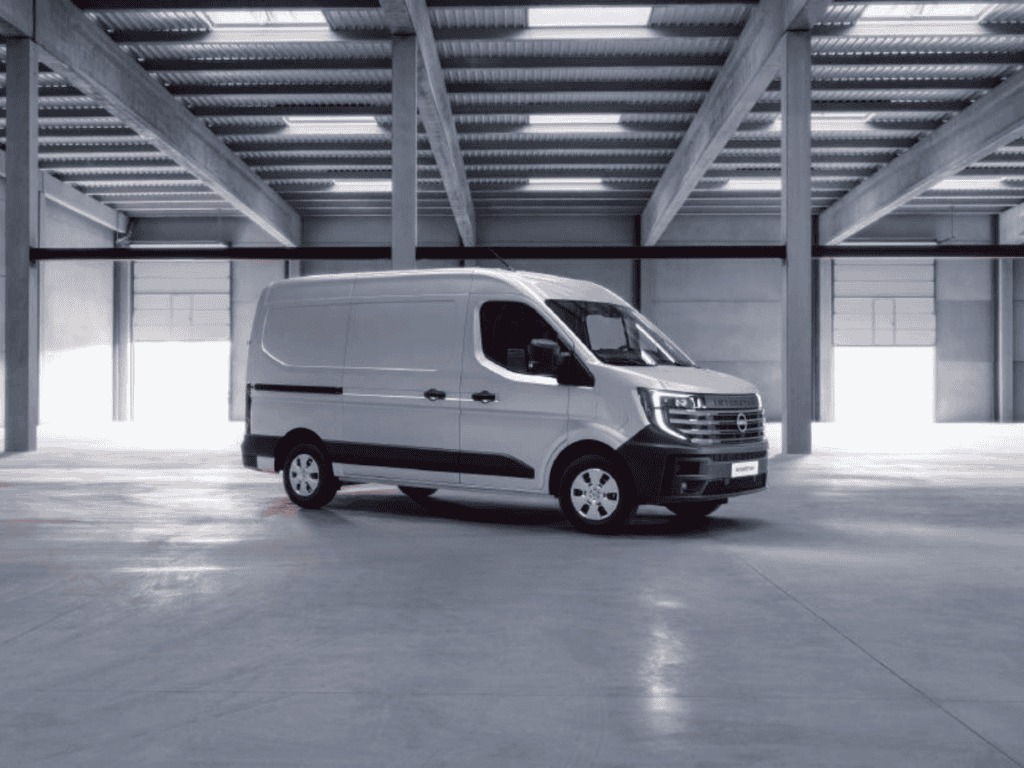
Nissan Interstar
The Nissan Interstar is a strong contender in the extra long wheelbase category. It’s ideal for heavy and bulky items.
- Load Area Dimensions: Length: 3214mm, Width: 1764mm, Height: 1912mm
- Maximum Payload: 1,413-1,606kg
Extra long wheelbase vans are perfect for couriers who need to transport very large items. Their spacious design and high payload capacity make them ideal for long-distance courier work.
Luton Vans
Luton vans are ideal for handling heavy and bulky items. They have a box-shaped cargo area that provides maximum storage space and often include a tail-lift for easy loading and unloading.
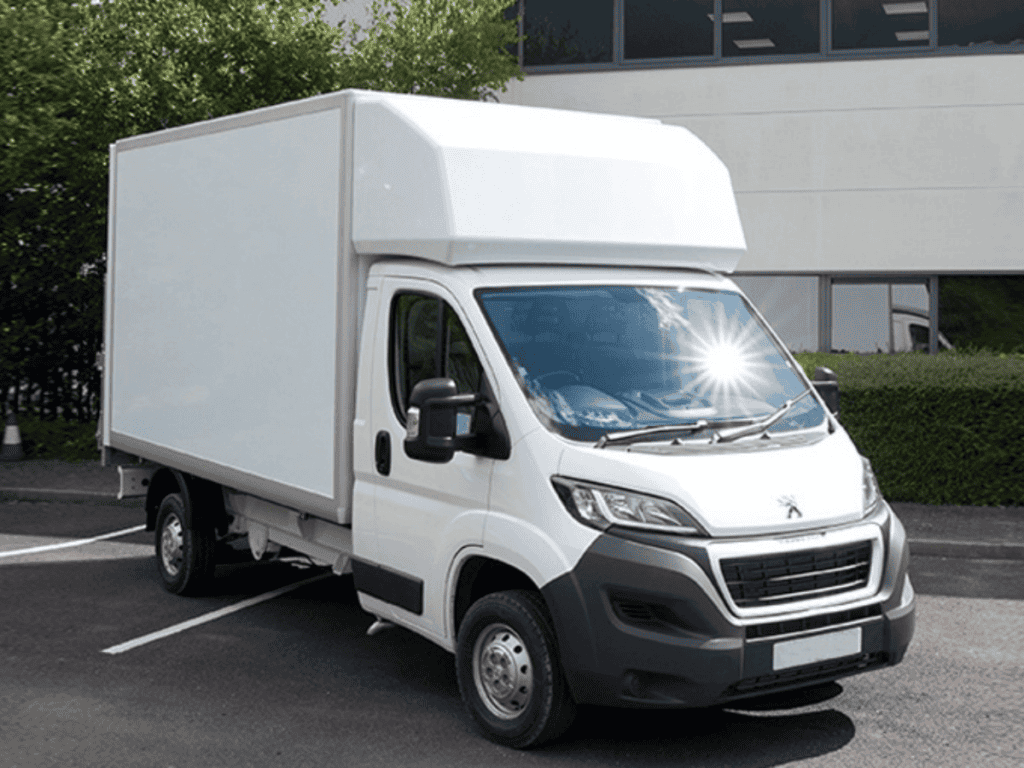
Peugeot Boxer Luton
The Peugeot Boxer Luton stands out for its robust build and reliability, making it perfect for transporting large and heavy loads.
- Load Area Dimensions: Length: 4,150mm, Width: 2,057mm, Height: 2,235mm
- Maximum Payload: 979-1,147kg
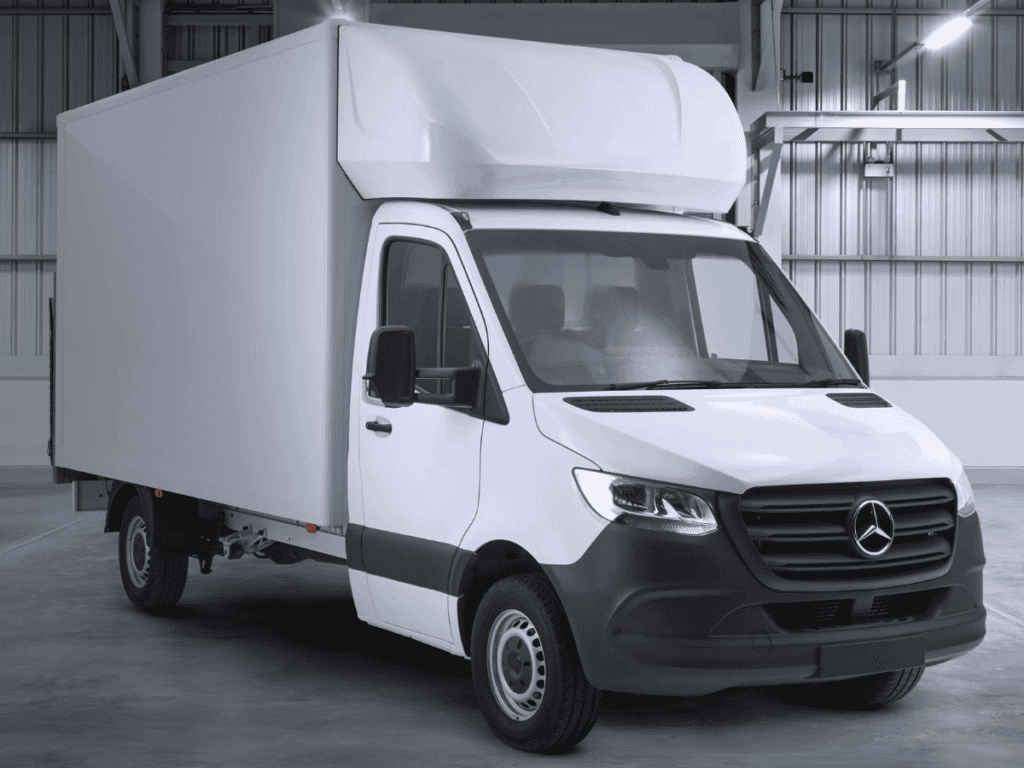
Mercedes-Benz Sprinter Luton
The Mercedes-Benz Sprinter Luton offers advanced safety features and a spacious cargo area, with a tail-lift that simplifies the handling of bulky items.
- Load Area Dimensions: Length: 4,080mm, Width: 2,025mm, Height: 2,235mm
- Maximum Payload: 754kg
Luton vans are perfect for couriers who need to transport large items. Their spacious cargo areas and included tail-lifts make loading and unloading easier. These vans provide a higher payload capacity, making them ideal for couriers dealing with bulky items regularly.
Conclusion
Choosing the right courier van for your courier business depends on your specific needs. For city deliveries, short wheelbase vans like the Renault Kangoo are perfect. Medium wheelbase vans such as the Renault Trafic offer a good balance of size and flexibility.
For larger loads, long wheelbase vans like the Renault Master are ideal. And for maximum cargo space, extra long wheelbase vans like the Peugeot Boxer are the best choice. Luton vans with tail-lifts offer additional benefits for handling heavy and bulky items, making them an excellent choice for couriers dealing with large packages.
If you want to find out how much you can earn in your area with each specific type of van, check out our earnings calculator.
Once you’ve decided on your ideal van, check out our guide for making sure you have the correct courier insurance.
Grow your business with Courier Exchange
Get access to 13,000+ loads a day, build your client list, and manage your finances.
Sign upThe courier industry in the UK is bigger than ever, offering many opportunities for owner-drivers and people who are new to the industry. Choosing the right location to operate in can make a big difference to your business. Some areas have more demand for couriers, better transport links, and more opportunities.
In this guide, we’ll explore the best locations for couriers and jobs in the UK, from the Midlands to the North, the South East, the South West, and London.
Get access to 13,000+ courier loads a day on Courier Exchange
Sign up
Be your own boss. Set your own hours. Make your own money.Locations we’ll cover

1. Birmingham
663 loads posted on CX per day (2024 daily average)
Birmingham is the UK’s second-largest city, with over 1.1 million residents. Known for its industrial history, the city is now a centre for business, retail, and manufacturing. It’s also home to the famous Bullring shopping centre and the NEC, one of the UK’s largest event venues.
Easily the best location for couriers
Birmingham’s central location provides excellent transport links. It’s well-connected by major motorways, including the M6, M5 and M42, making it easy to reach other parts of the UK.
Birmingham also has several large distribution centres and logistics hubs and sits with the so-called ‘golden triangle‘ of logistics centres. The high demand and good infrastructure in and around Birmingham make it a top location for courier work.

2. London
539 loads posted on CX per day (2024 daily average)
London, the UK’s capital, is home to nearly 9 million people. It’s one of the world’s most important financial and cultural centres, attracting millions of visitors and businesses. With its landmarks, shopping districts, and busy commercial areas, London is always on the move.
Why it’s one of the best locations for couriers
London has an extensive public transport and road network, making it easy to navigate. The city is home to major financial institutions and corporate headquarters, as well as many small and medium-sized enterprises (SMEs) that require regular deliveries.
The variety of businesses and the sheer volume of work available make London one of the best locations for couriers.

3. Nottingham
457 loads posted on CX per day (2024 daily average)
Nottingham, known for its links to Robin Hood, has a population of over 330,000.
It’s a vibrant city with two major universities and a strong economy based on retail, manufacturing, and services. The city centre is a hub of activity, with thriving markets and shopping areas.
Why Nottingham is a hotspot for couriers
Nottingham sits at the heart of the Midlands, making it a strategic location for deliveries.
It’s well connected by the M1 motorway, and its industrial estates create steady demand for courier services. E-commerce and retail businesses also drive frequent same-day deliveries.

4. Leicester
452 loads posted on CX per day (2024 daily average)
Leicester is one of the oldest cities in England, with a rich history dating back to Roman times.
Today, it’s home to around 360,000 people and is known for its textile industry, vibrant multicultural community, and strong sporting culture, including Leicester City FC.
Why Leicester is a top location for couriers
Leicester has a strong manufacturing and distribution sector, with many warehouses and industrial estates.
It’s located near the M1 and M69, providing easy access to major UK cities. The city’s thriving retail sector also creates high demand for courier services.

5. Coventry
394 loads posted on CX per day (2024 daily average)
Coventry, famous for its role in the UK’s car industry, has a population of around 350,000.
It’s also home to Coventry University and a growing tech sector, and is known for its rich cultural heritage. In fact, it was named the UK City of Culture in 2021.
Why Coventry is a busy city for couriers
Located near Birmingham and close to the M6, M69, and A45, Coventry is a key hub for logistics.
Many large businesses, including automotive and tech companies, require regular courier services. The city’s strong e-commerce sector also adds to delivery demand.

6. Manchester
383 loads posted on CX per day (2024 daily average)
Manchester is a major UK city with over 550,000 residents and a history rooted in industry and music. It’s known for its universities, football teams, and thriving nightlife. The city is also a major financial and business centre in the North of England.
Why it’s a prime location for couriers
Manchester has strong infrastructure, with extensive road and rail networks. The nearby Manchester Airport enables international freight, which increases the amount of courier driver jobs available. The city’s active economy and the large number of businesses create a constant demand for couriers.
If you’re looking for a bustling city with plenty of work opportunities, Manchester one of the top locations for courier work.
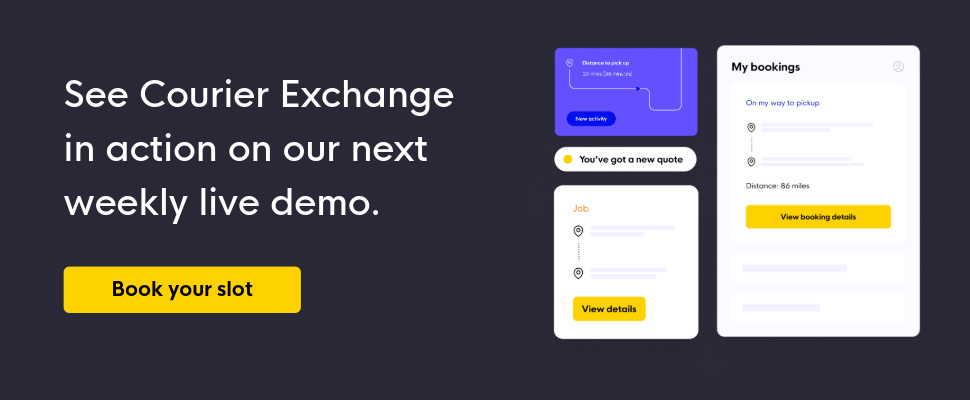

7. Sheffield
366 loads posted on CX per day (2024 daily average)
Sheffield, known as the Steel City, has a population of around 550,000. It has transformed from an industrial powerhouse into a modern city with strong healthcare, education, and retail sectors. Sheffield also has a large student population, adding to its lively atmosphere.
Why Sheffield is a hotspot for courier work
Sheffield’s location near the M1 makes it a key city for logistics. Many businesses in the area rely on couriers for manufacturing and retail deliveries.
The city’s growing e-commerce sector also boosts demand for fast and reliable courier services.

8. Northampton
363 loads posted on CX per day (2024 daily average)
Northampton, located in the East Midlands, is known for its historic shoe-making industry. With a population of around 230,000, it has a strong economy based on logistics, retail, and manufacturing. The town’s central location makes it a key business centre.
Why Northampton is a busy location for couriers
Northampton sits along the M1, providing fast transport links to London, Birmingham, and beyond. The town is a major hub for warehouses and distribution centres, creating steady work for couriers. Many national retailers and e-commerce companies operate from the area.

9. Derby
334 loads posted on CX per day (2024 daily average)
Derby, with a population of around 260,000, is known for its engineering and railway history. It’s home to Rolls-Royce, one of the world’s leading aerospace companies, as well as major rail and automotive firms. The city has a strong industrial and business presence.
Why Derby is an excellent location for couriers
Derby’s strong industrial base means a high demand for courier services, especially in engineering and manufacturing. The A38 and M1 provide key transport links, making deliveries across the region quick and efficient. The city’s businesses require regular logistics support.

10. Warrington
332 loads posted on CX per day (2024 daily average)
Warrington, a town in Cheshire, has a population of around 210,000. It has grown into a major business hub, with strong retail, technology, and logistics sectors. Its strategic location between Liverpool and Manchester makes it a key centre for trade and transport.
Why Warrington is a hotspot for couriers
Warrington is a major distribution centre, with many national and international companies operating warehouses in the area. It sits near the M6, M62, and M56, providing excellent road connections. This makes it a key location for couriers handling same-day and next-day deliveries.
The best locations for couriers in 2025 that works for you
All of these cities share several key features:
- They have excellent transport infrastructure, making it easy to navigate and reach different parts of the country.
- They also have high demand for courier services from diverse industries, ensuring a constant stream of work.
- Their central or strategic locations and the presence of major business hubs and distribution centres further enhance their appeal.
By choosing to operate in one of these prime locations, you can maximise your opportunities and grow your courier business.
If you want to find out how much you could earn with your vehicle type in your area, check out our potential earnings calculator.
Get access to 13,000+ daily loads on Courier Exchange
Be your own boss. Set your own hours. Make your own money.
Sign upAs a courier, you need the right courier insurance. It protects you, your vehicle, and your cargo.
In this guide, we’ll cover the key types of insurance every courier needs.
Get access to 13,000+ courier loads a day on Courier Exchange
Sign up
Be your own boss. Set your own hours. Make your own money.What we’ll cover
Hire and Reward Insurance
Hire and Reward insurance is a basic legal requirement. This courier insurance covers you when you transport goods for payment and is different from regular car insurance, which does not cover business use.
Why is this insurance so important? First, it protects you. If you have an accident while delivering goods, Hire and Reward insurance will cover the costs, including damage to your vehicle, other vehicles, and any medical expenses.
Second, getting caught without this insurance can result in heavy fines. It can also mean losing your license.
In short, Hire and Reward insurance is not just a good idea, but a must for every courier.
Goods in Transit Insurance
Goods in Transit (GiT) insurance is another necessary type of coverage. This courier insurance protects the goods you are carrying in case of theft, loss or damage. If something happens to the goods you are transporting, Goods in Transit insurance will cover the costs.
As a courier, you are responsible for the goods you carry. An accident with a large claim can be ruinous for your business if you don’t have the right level of coverage. To prevent this, CX requires all couriers on the platform to have at least £5,000 in Goods in Transit insurance coverage.
This courier insurance is especially important if you carry high-value items. But even if you transport everyday goods, you’ll still need it. Accidents and theft can happen at any time, but with Goods in Transit insurance, you have peace of mind, especially in the busier locations for couriers.
CMR Insurance
If you want to work in Europe, you’ll also need CMR insurance (International Carriage of Goods by Road) which covers you for international courier work, and is a legal requirement in many European countries.
CMR insurance covers you for loss, damage, and delay of goods when driving to and from European countries.
Choosing the right courier insurance provider
Finding the right insurance can be a challenge. That’s where our recommended insurance partner, Business Choice Direct (BCD), comes in. They offer comprehensive insurance solutions for couriers, including Hire and Reward and Goods in Transit insurance.
Our partnership with BCD means that all Courier Exchange members have access to their exclusive insurance products at competitive prices.
BCD not only price-match on any like-for-like van policy, but also ensure that your cover is tailored to the specific needs of your business.
Conclusion
As a courier, you need to protect yourself, your vehicle, and your cargo. Hire and Reward and Goods in Transit insurance are both essential for working in the UK. Couriers operating in and out of Europe also need CMR insurance and an Operator Licence. Having these protects you from financial loss and ensures you comply with legal requirements. And if you’re running a mixed fleet that includes HGVs, you’ll need to consider haulage insurance as well.
For the best deals on courier insurance, get in touch with Business Choice Direct and get an exclusive rate for CX members.
Grow your business with Courier Exchange
Get access to 13,000+ loads a day, build your client list, and manage your finances.
Sign upAs a courier, it’s important to stand out from the competition. By offering specialist courier services, you prove you can handle a variety of different types of cargo, and makes you the ideal choice for clients with specific requirements.
Whether you’re an owner-driver or running a small fleet, providing diverse services can increase your earning potential and open up new opportunities.
In this guide, we’ll explain the 17 specialist courier services and licenses you can add to your Courier Exchange profile and offer to your customers, both on and off the Exchange.
Get access to 13,000+ courier loads a day on Courier Exchange
Sign up
Be your own boss. Set your own hours. Make your own money.What we’ll cover
What are specialist courier services?
The courier industry is packed with competition, and many couriers offer similar services. However, by diversifying and offering specialist courier services, you create a unique value proposition for your business.
These services cater to specific types of cargo that require extra care, equipment, or expertise. Whether you’re handling delicate goods, time-sensitive deliveries, or hazardous materials, offering these services demonstrates your versatility and reliability.
Specialist courier services not only help you attract more customers but also allow you to charge higher rates. Many of these services are in demand across niche industries like healthcare, fashion, or construction, where customers are willing to pay for expertise.
By diversifying your offerings, you create a unique value proposition that makes you the go-to choice for customers with specific needs.
It’s not just about moving goods from point A to point B; it’s about providing tailored solutions that address the unique challenges your customers face.
The 17 specialist courier services you can offer
2-Man jobs: Extra manpower for bulky or delicate items
One of the most sought-after specialist courier services is the 2-man job.
When customers need help moving heavy or awkward items, having two couriers on hand can make all the difference. This service is ideal for transporting large furniture, office equipment, or appliances that are too cumbersome for a single driver to manage.
Offering 2-man jobs not only allows you to transport more sizeable items but also gives customers peace of mind knowing their goods are in safe hands. Additionally, this specialist courier service can extend to other tasks, such as helping to install items like refrigerators or washing machines, increasing the value you provide to customers.
24-hour service: Meeting urgent delivery needs
The 24-hour courier service is vital for urgent or after-hours deliveries.
Customers often need items delivered outside of regular working hours, whether it’s emergency parts for machinery, last-minute gifts, or time-sensitive documents. By offering a 24-hour service, you can cater to these urgent requests and charge a premium for your availability.
Being available around the clock can make your Courier Exchange profile more attractive, especially to businesses that rely on quick, reliable delivery. This specialist courier service is often needed by industries like healthcare or tech, where delays could lead to significant disruption.
ADR: Transporting dangerous goods safely
If you’re interested in transporting hazardous materials, ADR is a popular specialist courier service that’s always in demand.
ADR stands for “Agreement concerning the International Carriage of Dangerous Goods by Road,” and it covers a wide range of items, including chemicals, flammable substances, and explosives.
With the right qualifications, you can safely and legally transport these materials, giving customers the confidence that their dangerous goods are in good hands.
As an ADR-certified courier, you’ll be able to take on high-value and high-risk deliveries that others cannot. Whether you’re transporting industrial chemicals or pharmaceutical products, having ADR certification allows you to tap into more lucrative opportunities.
Learn more about ADR certification in our detailed guide, including course costs and recommended providers.
DGSA Qualified: Ensuring safety with hazardous goods transport
Similar to ADR, becoming a Dangerous Goods Safety Advisor (DGSA) adds another layer of expertise to your profile.
As a DGSA-qualified specialist courier service, you’re responsible for ensuring that hazardous materials are transported safely and in compliance with legal requirements. This includes everything from advising customers on the best packaging methods to ensuring that all transport documentation is accurate.
Being a DGSA-qualified courier can set you apart in a competitive field, as it shows customers that you prioritise safety and legal compliance. This qualification is often required by businesses that regularly deal with dangerous goods, such as chemicals or electronics manufacturers.
FORS: A badge of fleet operational excellence
FORS (Fleet Operator Recognition Scheme) is a valuable accreditation that highlights your commitment to operational standards. Whether you have a single van or you’re managing a courier fleet, FORS ensures that you meet industry best practices in areas like safety, emissions, and noise pollution.
The FORS accreditation has three levels: Bronze, Silver, and Gold. Each level represents a higher standard of operations, with Bronze focusing on compliance, Silver on maintaining safety equipment, and Gold on achieving excellence in environmental performance.
Earning FORS accreditation can enhance your credibility with customers and provide you with more high-value courier jobs.
GOH (Garments on Hanger): A fashion industry must-have
If you’re looking to cater to the fashion industry, Garments on Hanger (GOH) specialist courier services are a great addition to your offerings.
This service is designed for transporting clothing items, especially delicate garments like suits or dresses, that need to arrive wrinkle-free and ready to wear.
Offering GOH transport means you can take on high-value deliveries for fashion retailers and designers. This service requires careful handling and specialised equipment to keep garments hanging during transport, ensuring they remain in top condition.
High-security transport: Handling valuable or sensitive goods
High-value items, such as jewellery, electronics, or confidential documents, require special care during transport.
Offering high-security transport means implementing enhanced safety measures, such as GPS vehicle tracking, keeping your courier van secure with proper locks, and possibly even armed guards.
Customers in sectors like finance, law, and high-end retail often require this type of service to safeguard valuable or sensitive materials. As a high-value courier, you can take on these lucrative jobs with the assurance that your customers’ goods are protected at all times.
Installation and swap-out services: More than just delivery
Offering installation and swap-out services adds a level of convenience for your customers.
This specialist courier service often goes hand-in-hand with transporting bulky items like appliances, office furniture, or electronics. It involves not only delivering the items but also installing them or swapping out old models for new ones.
This type of service is commonly required in sectors like construction, home appliances, and office relocations, making it a great way to expand your offerings and attract new customers.
Aviation certifications: Level A/B and cargo operative roles
If you frequently deliver goods to and from airports or air freight facilities, you may need specific aviation certifications.
The Level A/B and cargo operative certifications are necessary for handling airport cargo and ensuring it meets aviation security standards. These certifications demonstrate your ability to safely manage airside deliveries, whether it’s pharmaceuticals, electronics, or emergency parts for airlines.
Having the right aviation certifications and a courier ID badge allows you to take on high-priority jobs and gain access to the bustling air freight market.
Frozen transport: Keeping goods at the right temperature
When it comes to transporting frozen items, you need the right equipment to maintain the proper temperature throughout the journey.
Whether you’re delivering ice cream, pharmaceuticals, or food products, offering a frozen transport service ensures that goods arrive at their destination in the best condition.
Transporting frozen goods can be tricky, as it requires specialised refrigeration systems and a careful monitoring process. However, by offering this specialist courier service, you can attract customers in industries like food distribution or medical research, who need their temperature-sensitive goods delivered quickly and securely.
Refrigerated and chilled transport: Meeting temperature-sensitive needs
Refrigerated and chilled transport services cater to a wide variety of goods, from dairy products and fresh flowers to pharmaceuticals that need to be kept cool but not frozen.
These specialist courier services require vans with temperature-controlled systems that can maintain a consistent chill throughout the journey.
Offering both refrigerated and chilled transport allows you to meet the needs of industries that rely on cold chain logistics, including the food and healthcare sectors.
Removals: Offering full-service moving solutions
Providing removal services is a great way to expand your courier offerings.
This involves not only transporting household or office items but also offering a complete service, including packing, loading, and unloading. Removals can be a time-consuming job, but they often pay well and provide customers with a hassle-free experience.
By adding removals to your specialist courier services, you can tap into a wide market that includes individuals, businesses, and property management companies.
Waste carrier: Legal and responsible waste transportation
To transport waste materials, you need to be a licensed waste carrier.
This includes transporting materials like construction debris, old electronics, or general rubbish. By offering waste carrier services, you’re ensuring that customers’ waste is disposed of in an environmentally responsible manner, following all local regulations.
Having a waste carrier licence helps you tap into the growing demand for sustainable and legal waste disposal. Whether it’s construction companies or households, there’s always a need for reliable waste transport.
WEEE: Safe disposal of electrical and electronic equipment
With growing concerns over electronic waste, offering WEEE (Waste Electrical and Electronic Equipment) services is a great way to stay ahead.
This specialist courier service involves handling and disposing of old electronics, like computers, televisions, and refrigerators, in an environmentally safe manner.
With the rise in electronic waste, many businesses and consumers require specialised disposal services. By offering WEEE services, you can cater to a wide range of customers and ensure they remain compliant with environmental regulations.
Authorised Economic Operator (AEO): Facilitating international trade
If you frequently handle international shipments, becoming an Authorised Economic Operator (AEO) is an excellent way to boost your reputation. This status shows that you meet high standards for customs and trade compliance, helping you move goods across borders with fewer delays and checks.
AEO status allows you to handle international shipments more smoothly, making it easier for you to take on cross-border jobs and increase your earning potential.
CMR insurance: Safeguarding international deliveries
For international deliveries, CMR insurance is a must-have.
This type of insurance provides protection for goods transported across borders under the CMR convention, offering legal protection in case of loss or damage during transit.
Having CMR insurance can give you an edge when bidding for high-value international courier jobs.
Offer a diverse range of services to stay competitive
Adding specialist courier services to your offerings not only expands the types of jobs you can take on but also positions you as a trusted and reliable option for customers with specific delivery needs. These services often come with higher rates, as customers are willing to pay more for the expertise and care required to transport their goods safely.
By showcasing your specialist services on platforms like Courier Exchange, you can attract a wider customers base and secure higher-paying owner-driver courier jobs. Verified profiles stand out, helping you connect with customers who need the specific capabilities you offer, increasing your chances of filling your van more frequently. This, in turn, can significantly help with growing your courier business.
If you’re looking to expand your services, now could be a great time to consider buying or leasing a courier van that suits your new specialist needs. Regular courier van maintenance ensures that your vehicle is ready for these additional jobs, keeping you on the road and making money. Don’t miss out – start adding these specialist courier services today and watch your business grow.
Grow your business with Courier Exchange
Get access to 13,000+ loads a day, build your client list, and manage your finances.
Sign upAs an owner driver, jobs are easy to pick up wherever you happen to be in the country with the Courier Exchange app. If you happen to take on a load in London when you’re not a native to the Capital, the idea of finding your way around its notoriously fiendish road network can be intimidating to say the least.
But don’t let it dissuade you from accepting the work. Follow these simple steps before negotiating the delivery schedule for your London load.
Get access to 13,000+ courier loads a day on Courier Exchange
Sign up
Be your own boss. Set your own hours. Make your own money.What we’ll cover
1. Do Your Research
London is a vibrant capital city where no two days are the same. One very handy piece of advice for couriers is to check online for any possible disruptions before you start planning your journey. It’s entirely possible that your route could be affected by one of the following:
- Planned road works
- Transport strikes
- Demonstrations, festivals or parades
- Building work
It would be foolish, for example, to agree to a quick delivery in West London on the weekend of the Notting Hill Carnival. Of course there will always be the chance of last-minute traffic problems or road closures, but it is worth checking online beforehand to save time (and patience) later.
2. Give a Generous Time Estimate
As an owner driver, don’t be tempted to accept multiple cross-London deliveries in a single day. Courier jobs may come in thick and fast, but customer satisfaction and a delivery schedule you can stick to are more important than completing multiple jobs quickly.
You can be sure that the traffic in the Capital will move at an agonisingly slow pace, no matter the hour of your delivery. It’s easy to get frustrated when you’re sat at a standstill in a queue, but don’t add to the pressure by giving yourself a schedule you can’t hope to meet.
3. Map Out Your Route Ahead of Time
It may sound obvious, but a wing and a prayer just don’t cut it when it comes to navigating London. We would always recommend checking your route options on both a conventional map and a Sat Nav before you set out on your journey. That way you can gain an understanding of the lay of the land and identify two or three routes that would get you to your destination, before picking the most sensible one.
4. Stick to Your Plans When Navigating London
Once you have chosen your route, take the advice of the London Hackney Club (otherwise known as black cabbies, to you and me): even if you have years of navigation under your belt and know the streets of London like the back of your hand, a lot of the time traffic jams can’t be avoided.
Try not to stray from your chosen route – attempting to “get around the traffic” will only lead to frustration and potentially add precious minutes to your delivery time.
5. Two Pairs of Eyes are Better Than One
It can really help to have a second pair of eyes in the cab with you when you’re driving in an inner city with multiple lanes and exits.
We’ve all been in that situation when your Sat Nav gives you an unclear instruction and you’re craning around to find the correct turning. A mate on the seat beside you can keep a look out for road signs and man the phone while you’re navigating London, allowing you to focus all of your efforts on the road. Of course, a second pair of hands also comes in useful when it’s time to unload at your destination.
Follow these simple steps, keep a cool head and you’ll be planning your London routes like a true Londoner in no time!
If you’re not based in London, check out our guide to the best locations for couriers.
Grow your business with Courier Exchange
Get access to 13,000+ loads a day, build your client list, and manage your finances.
Sign upAs an owner drivers, you know that delivering goods efficiently and on time is crucial to your success. However, despite meticulous planning and preparation, unexpected delays and disruptions can sometimes occur, causing frustration for both you and your customers. In this article, we will explore some practical tips on how to handle these unforeseen challenges and ensure your deliveries stay on track.
Stay Informed and Be Prepared:
To effectively handle unexpected delays, it is vital to stay informed about any potential disruptions that may impact your route or schedule. Courier Exchange, a leading platform for owner drivers and courier companies, offers valuable real-time information and updates on traffic conditions, road closures, and other relevant factors. Utilize this platform to stay ahead of the game and plan your routes accordingly. View our Live Loads Map here.Communicate with Your Customers:
Communication is key when facing unexpected delays. Notify your customers promptly if you encounter any issues that may affect the agreed delivery time. Use clear and concise language to explain the situation, apologize for the inconvenience caused, and provide an estimated revised delivery time. By keeping your customers informed, you can manage their expectations and maintain a positive professional relationship.Seek Alternative Routes or Delivery Options:
When confronted with unexpected delays, explore alternative routes that may help you bypass the congestion or obstacle. Utilize GPS navigation systems or apps to find the most efficient detour. Additionally, consider alternative delivery options, such as drop-off points or collection hubs, where customers can retrieve their parcels conveniently. Flexibility is key in ensuring successful deliveries despite disruptions. Read more about our TMS integrations here.Collaborate with Other Owner Drivers:
The Courier Exchange platform can also facilitate collaboration and cooperation among owner drivers and couriers. In case of unexpected delays, consider reaching out to nearby drivers who may be able to assist in delivering your parcels or taking over certain routes. By working together, you can minimize the impact of disruptions and maintain a high level of customer satisfaction.Maintain a Contingency Plan:
Preparing a contingency plan is essential to handle unforeseen events smoothly. This plan should include alternative delivery routes, backup drivers or vehicles, and contact information for customer support or dispatch. By having a well-thought-out contingency plan in place, you can act swiftly and efficiently in the face of unexpected delays, minimising any potential negative impact.
As an owner driver or courier company, dealing with unexpected delays and disruptions is an inevitable part of the job. By staying informed, communicating effectively, exploring alternative options, collaborating with fellow drivers, and maintaining a contingency plan, you can navigate through these challenges and ensure your deliveries are completed successfully. Remember, being adaptable and proactive is the key to maintaining customer satisfaction and running a successful delivery business.
To learn more about our pricing and plans, click here.In the fast-paced world of logistics and transportation, efficiency and reliability are crucial elements for success. The traditional method of handling paper-based proof of delivery (POD) systems has long been a bottleneck in the industry, leading to delays, errors, and inefficiencies. However, with the advent of electronic proof of delivery (ePOD) systems, such as those found on platforms like Courier Exchange, the landscape of delivery management has been revolutionised. This blog post explores the concept of ePODs, their benefits, and how they’re transforming the courier industry.
Electronic Proof of Delivery (ePOD) is a digital alternative to the traditional paper-based POD system. It enables real-time tracking and captures detailed information about the delivery process, providing visibility and accountability to all parties involved. Courier Exchange, a leading online platform for freight exchange and courier work, has embraced ePOD technology to optimize delivery operations and enhance customer satisfaction.
Why should owner drivers use ePODs?
Real-time Tracking and Visibility
With ePODs, couriers and freight forwarders can track deliveries in real-time, allowing them to monitor the progress of each shipment accurately. This increased visibility enables better communication with customers, as they can be informed about estimated delivery times and any potential delays. It also allows dispatchers and logistics managers to proactively manage routes and address any issues that may arise promptly.
Enhanced Efficiency and Productivity
By eliminating the need for paper-based documentation, ePOD systems reduce manual paperwork and administrative tasks. Owner drivers can efficiently capture signatures, delivery photos, and relevant data electronically using smartphones or tablets. This streamlined process saves time, reduces errors, and enables drivers to focus on their primary task—efficiently transporting goods.
Improved Customer Experience
One of the key advantages of ePOD systems is their ability to provide customers with real-time updates and notifications. With Courier Exchange’s ePOD functionality, customers can receive automated notifications about the status of their deliveries, including proof of delivery with signatures and timestamps. This transparency builds trust, enhances the customer experience, and promotes customer loyalty.
Accurate Documentation and Record Keeping
ePOD systems offer the advantage of accurate and easily accessible digital records. All relevant delivery data, including signatures, timestamps, and any special instructions, are securely stored and readily available for future reference. This eliminates the need for physical storage space and minimises the risk of losing important documentation, making audits and compliance procedures much more efficient.
Electronic Proof of Delivery (ePOD) systems have emerged as a game-changer in the courier industry, streamlining delivery operations, enhancing efficiency, and improving customer satisfaction. Courier Exchange’s ePOD functionality provides real-time tracking, accurate documentation, and increased visibility, enabling couriers to deliver an exceptional customer experience. By joining our platform and using this feature, logistics companies can stay ahead of the competition, reduce costs, and contribute to a greener and more sustainable future in the transportation sector.
If you’re interested in the freedom and flexibility of owner driver jobs in the courier industry, Courier Exchange offers a valuable platform to connect with businesses and secure courier contracts in the UK.
Whether you’re starting your own courier business or looking to expand your existing operations, this article will guide you through the essential steps to become a successful courier on Courier Exchange and secure lucrative contracts.
Obtain the necessary licenses and permits
Before starting your journey as a courier, it’s crucial to ensure you have the appropriate licenses and permits. In the UK, you will typically need a valid driver’s license, vehicle insurance, and vehicle registration documents. If you plan to transport certain goods or operate specific types of vehicles, additional permits or certifications may be required. Familiarise yourself with the legal requirements to operate as a courier in your area.
Build a reliable and suitable vehicle fleet
Your vehicle is the backbone of your courier business. Ensure you have a reliable and well-maintained fleet of vehicles suitable for the type of deliveries you intend to handle. Consider factors such as vehicle size, capacity, fuel efficiency, and any specialised requirements for specific types of deliveries. Maintaining your vehicles in optimal condition is essential to provide a reliable and efficient service to your clients.
Obtain appropriate insurance coverage
Insurance is a vital aspect of operating as a courier. Adequate insurance coverage protects you, your vehicle, and the goods you transport. It’s crucial to have comprehensive commercial vehicle insurance that covers any potential risks associated with courier services. Consult with insurance providers specialising in the courier industry to ensure you have the necessary coverage for your business.
Develop a professional online presence
Establishing a professional online presence is crucial for attracting potential clients and securing courier contracts on and off the Courier Exchange. Create a website that highlights your services, coverage area, and contact information. Utilise social media platforms to promote your business and engage with potential clients. Positive customer reviews and testimonials can enhance your credibility and reputation, increasing your chances of securing contracts.
Provide exceptional customer service
Delivering exceptional customer service is key to building a strong reputation and securing repeat business. Strive to exceed customer expectations by ensuring timely and secure deliveries, maintaining open communication, and addressing any issues promptly and professionally. A satisfied customer is more likely to provide positive feedback and recommend your services to others, increasing your chances of securing more contracts.
Leverage Courier Exchange features
Courier Exchange offers various features and tools to help you secure courier contracts effectively. Utilise Future Positions and Future Journeys to advertise your availability and expand your reach. Regularly check the platform for new delivery requests and promptly respond to notifications to demonstrate your reliability. Familiarise yourself with Courier Exchange’s payment and rating systems to ensure a smooth and transparent transaction process.
Becoming a successful courier on Courier Exchange requires careful planning, dedication, and a commitment to providing exceptional service. By following the essential steps outlined in this article, such as obtaining the necessary licenses and permits, registering on Courier Exchange, building a reliable vehicle fleet, acquiring appropriate insurance coverage, developing a professional online presence, delivering outstanding customer service, and leveraging Courier Exchange features, you can position yourself for success in securing lucrative courier contracts in the UK.
Remember, persistence and a customer-centric approach are essential to thrive in the competitive courier industry.
Solutions
Resources
Support
About
2000 - 2025. Transport Exchange Group Ltd, Reg No. 3464353 © E&OE
- Owner drivers